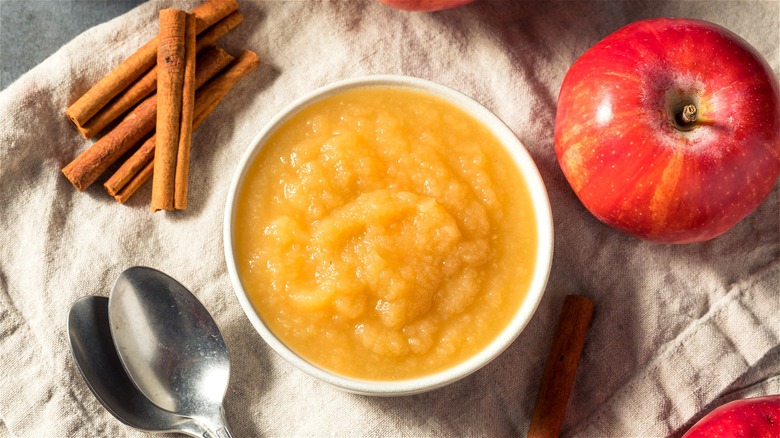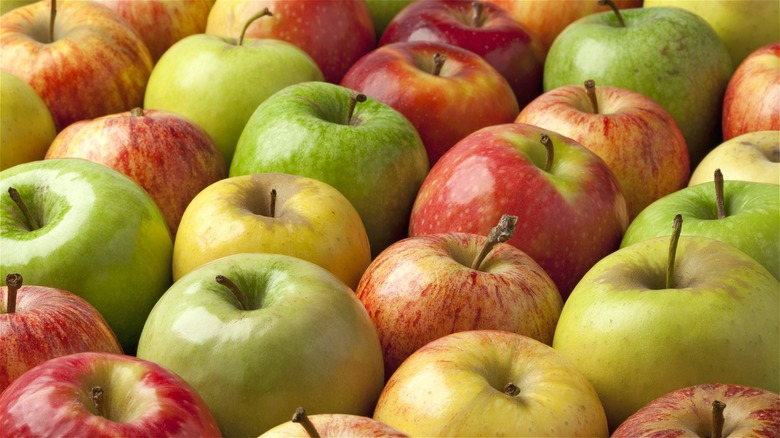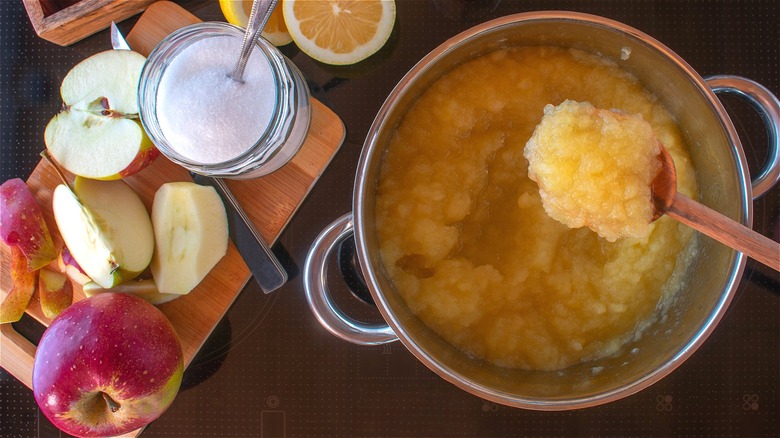For The Absolute Best Applesauce, Choose Your Apples Wisely
Out of everything you need to eat, drink, and do this fall, preparing delicious seasonal treats tends to be a favorite pastime for many home chefs. Besides leaning into the warm, comforting flavors that signify the autumn season, such as maple, cinnamon, pumpkin, and sage, most food lovers can't resist the countless varieties of apples available during the prime months of August through November. Besides making homemade apple pie and apple chips, you might feel the urge to make a large batch of applesauce just to enjoy more than one apple variety in one sitting. But with so many kinds of apples to choose from, you may feel overwhelmed when having to decide which varieties work best when cooked down in a pot with sugar, salt, lemon juice, and water.
When in doubt, pick more than one variety to give your applesauce some depth of flavor, and opt for varieties you wouldn't normally choose for everyday snacking. Not many people enjoy biting into apples with soft flesh, so choosing apples that have the ability to cook down easily without turning to mush is essential.
The best apples for applesauce
To make a tasty pot of applesauce, you don't need to memorize all of the different types of apples and how to use them. While you may be used to choosing the every-popular honeycrisp and gala varieties for everyday snacking, you'll want to be a little more methodical when picking the right assortment for applesauce. Choosing softer apples tends to work out in your favor, as the process of breaking down will be a bit more streamlined.
If you're aiming to use two to three kinds of apples, your best bet is to choose apples not only for their soft flesh but also for their level of sweet and tart flavors. This allows you to give your sauce a nicely developed taste. Golden delicious apples work as the perfect anchor for any applesauce, as they have a delicate flavor with a mild degree of sweetness. For a sweeter apple, Fuji apples are recommended, as they have a higher concentration of sugar than most other varieties.
When choosing apples for tartness, Jonagold, McIntosh, and Cortland apples are all recommended. McIntosh apples are able to break down with ease, while Jonagold apples will provide your sauce with a truly complex flavor due to their inherent genetic makeup of both Golden Delicious and Jonathan apples.
Not all apples should be turned into applesauce
Now that you're aware of the most common varieties suggested for homemade applesauce, there's one type of apple you should avoid for any future sauce-making ventures. While you might enjoy snacking on a red delicious apple in between bites of your ham and cheese sandwich at lunchtime, these apples are not recommended for applesauce. Even though the burgundy skin of Red Delicious apples is perfect for giving your applesauce a rosy pink hue, the skin is difficult to break down under heat. The flesh of this variety also has a tendency to turn mealy, which can lead to an off-putting mouthfeel.
Besides steering clear of red delicious apples, you can choose any assortment of apples for your next homemade batch of applesauce. A lot of the suggested varieties come down to personal taste. For example, some home chefs find granny smith apples to be too tart for applesauce. However, as long as you're choosing a good mix of sweet and sharp-tasting apples, you're well on your way to making a delicious pot of sauce.
Regardless of which varieties you choose, leave your apple skins intact. Apple skins not only provide a hint of color, but they also add a significant amount of flavor and nutrition.


